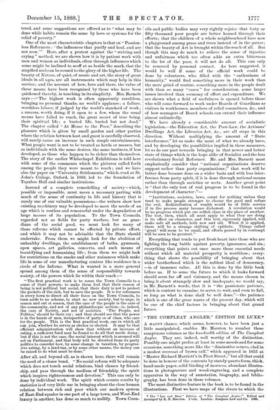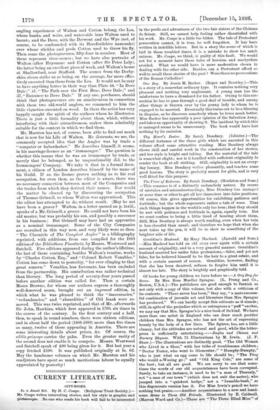" THE COMPLEAT ANGLER," EDITION DE LUXE.*
A HAPPY chance, which seems, however, to have been just a little manipulated, enables Mr. Marston to number these sumptuous volumes as the hundredth edition of The Compleat Angler. They are, indeed, well worthy of the distinction. Possibly one might prefer, at least in some moods and for some occasions, something more like the diminutive octavo, clad in a modest overcoat of brown calf," which appeared in 1653 at "Master Richard Marriott's in Fleet Street ;" but all that could be done in honour of the contents by stately quarto form, thick, hand-made paper, solid binding of morocco, abundant illustra- tions in photogravure and wood-engraving, and a complete apparatus in the way of annotation, biography, and biblio- graphy, has been done in these volumes.
The most distinctive feature in the book is to be found in the illustrations. First we have maps of the rivers to which the
• The "Lea and Dore" Edition of "The Compleat Angler." Edited and Arranged by R. B. Marston. 2 sole. London : Sampson Low and Co. US& angling experiences of Walton and Cotton belong, the Lea, whose banks, and weirs, and water-side inns Walton used to haunt ; and the Dove, with the Derwent and the Wye (not, of course, to be confounded with its Herefordshire namesake) over whose stickles and pools Cotton used to throw his fly. Then come the photogravures, fifty-four in number. Most of these represent river-scenes ; but we have also portraits of Walton (after Huysman) and Cotton (after Sir Peter Lely), the latter being an excellent piece of work, and Walton's house at Shallowford, near Stafford. The scenes from the Derby- shire rivers strike us as being, on the average, far more effec- tively executed than those from the Lea. It would not be easy to have anything better in their way than Plate 44, " In Dove Dale ;" 41, " The Path over the First Brae, Dove Dale ;" and 37, " Entrance to Dove Dale." If any one, perchance, should think that photogravures are an anachronism in connection with these two old-world anglers, we commend to him the little vignettes executed on wood. In them the artist has very happily caught the spirit of the authors whom he illustrates. There is just a little formality about them, which, without interfering with their attractiveness, makes them admirably suitable for the context in which we find them.
Mr. Marston has not, of course, been able to find out much that is new for his Life of Walton. He distrusts, we see, the commonly accepted idea that the Angler was by trade a " sernpster or haberdasher." He describes himself, it seems, in his marriage-licence as an " ironmonger." The question is whether this means that he was an ironmonger by trade, or merely that he belonged, as he unquestionably did, to the Ironmongers' Company. We take it that in a formal docu- ment, a citizen of London describes himself by the name of his Guild. If so, the licence proves nothing as to his real occupation, for even then, as the editor is aware, there was no necessary connection between most of the Companies and the trades from which they derived their names. Nor would the matter be cleared up by discovering the occupation of Thomas Grinsell, to whom Walton was apprenticed. This the editor has attempted to do, without result. (May he not have been a grocer P Walton, in a letter quoted on p. lxxiii., speaks of a Mr. Grinsell, a grocer. He could not have been his old master, but was probably his son, and possibly a successor in his business.) But Grinsell may have had an apprentice as a nominal ironmonger. Some of the City Companies are recruited in this way now, and very likely were so then. " The Chronicle of The Compleat Angler" is a bibliography reprinted, with additions, from one compiled for the 1883 edition of the Bibliotheca Piscatoria, by Messrs. Westwood and
Satchell. Five editions appeared during the author's lifetime, the last of these containing, besides Walton's treatise, works by "Charles Cotton, Esq.," and " Colonel Robert Venables."
Cotton has come down to posterity, " for ever clinging to that great renown." Venables, less fortunate, has been excluded from the partnership. His contribution was rather technical than literary. The long period of seventy-four years passed before another edition was called for. Then a certain Moses Browne, for whom our authors express a thoroughly well-deserved scorn, brought out an improved edition, in which what he was pleased to think the " inaccuracies," "redundancies," and " absurdities " of Old Isaak were re- moved. This was twice reprinted, and that of Mr., afterwards Sir John, Hawkins, which first appeared in 1760, six times in the course of the century. In the first century and a half, then, to speak in round numbers, there were sixteen editions, and in about half the period (1808-1888) more than five times as many, twelve of these appearing in America. There are
some interesting details about prices, &c. Of course, the editio princeps carries the palm. Even the greater rarity of
the second does not enable it to compete. Messrs. Westwood and Satchell speak of 280 being given for it. But last year a copy fetched 2190. It was published originally at ls. 6d.
May the handsome volumes on which Mr. Marston and his coadjutors have spent so much meritorious labour be equally appreciated by posterity !















































 Previous page
Previous page